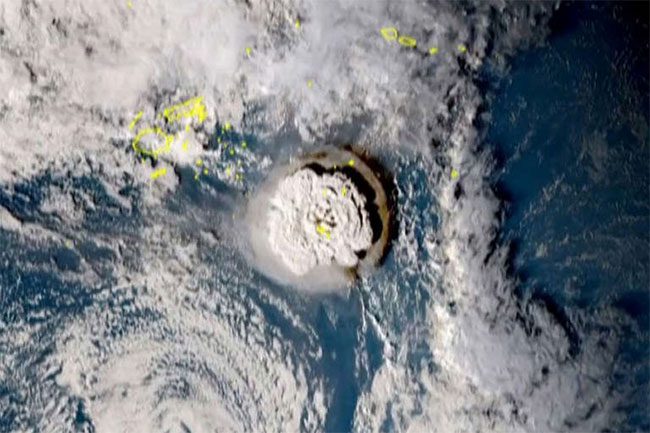The eruption of the Hunga Tonga-Hunga Ha’apai volcano, which caused a powerful tsunami off the coast of the Tonga Islands in the Pacific in 2022, led to unprecedented fast-moving underwater flows. This conclusion was drawn in a study published in the September 8 issue of the journal Science.

Satellite image: Volcano eruption causing tsunami in Tonga. (Photo credit: AFP/TTXVN)
This research was conducted by a team of scientists from the UK’s National Oceanography Centre (NOC). The scientists recorded that the Hunga Tonga-Hunga Ha’apai volcano erupted rocks, ash, and gas across the seafloor at a speed of 122 km/h in January 2022. This eruption is the strongest recorded to date using modern equipment. The eruption triggered a violent tsunami and “avalanche-like flows”, damaging underwater telecommunications cables that connect the Tonga Islands to the rest of the world. The research team calculated the velocity of the flows based on the timing and location of the cable damage.
According to scientist Mike Clare from the NOC, the eruption column of the volcano reached heights of 57 km, pouring directly into the ocean and down the steep underwater slopes. The speed and intensity of the currents were so great that they could travel at least 100 km along the seafloor, severing cables. The flows generated by the volcanic eruption moved faster than those caused by earthquakes, floods, and storms. Meanwhile, researcher Isobel Yeo, also from the NOC, noted that many volcanoes lie beneath the ocean but are rarely monitored, which leaves the risks to coastal communities and critical infrastructure “not well understood.”
This is the first study to document what occurs when a large volume of volcanic material erupts directly into the ocean. Scientists estimate that the 2022 eruption of the Hunga Tonga-Hunga Ha’apai volcano released a force equivalent to hundreds of atomic bombs.



















































